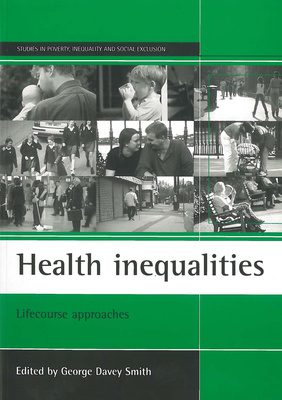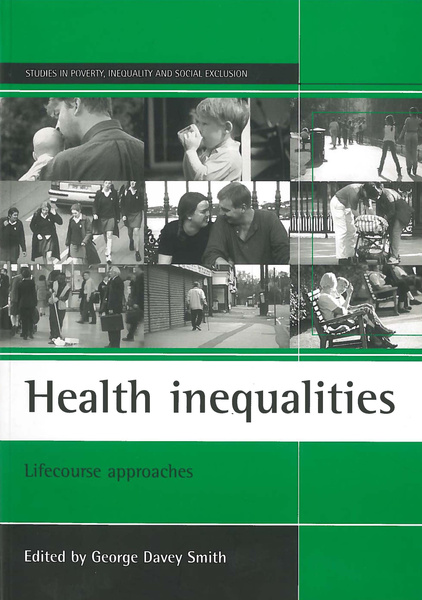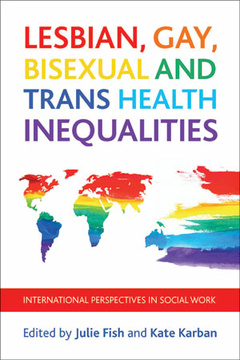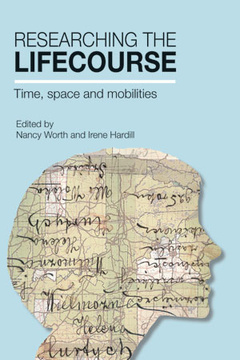Published
Aug 14, 2003Page count
608 pagesBrowse the series
Studies in Poverty, Inequality and Social ExclusionISBN
978-1861343222Dimensions
240 x 172 mmImprint
Policy PressThe lifecourse perspective on adult health and on health inequalities in particular, is one of the most important recent developments in epidemiology and public health. This book brings together, in a single volume, the work of one of the most distinguished academics in the field. It is the first to specifically take a lifecourse approach to health inequalities and will be essential reading for academics, students and policy makers with an interest in public health, epidemiology, health promotion and social policy.
"... a fascinating volume: provocative and challenging, often humorous but never dull." Health Service Journal
"For anyone who teaches, writes or even has only a passing interest in the field of health inequalities this volume would definitely be value for money and a useful resource to have at hand. The readability of the papers will also lead to use by both undergraduate and graduate students alike." Health Economics
"This book will become a classic for those interested in health inequalities." Jenny Roberts, London School of Hygiene and Tropical Medicine
"This book provides the epidemiological background for a new and important way of thinking about how and when we intervene to reduce health inequalities. Professor Davey Smith's research on the life course and health is truly innovative and unique. Many academics from diverse disciplines will want this as part of their permanent libraries." John Lynch, School of Public Health, University of Michigan
"This book provides the epidemiological background for a new and important way of thinking about how and when we intervene to reduce health inequalities. Professor Davey Smith's research on the life course and health is truly innovative and unique. Many academics from diverse disciplines will want this as part of their permanent libraries." John Lynch, School of Public Health, University of Michigan
George Davey Smith is Professor of Clinical Epidemiology at the University of Bristol. He has contributed extensively to the health inequalities literature, particularly from a lifecourse perspective.
Section I: Patterns of health inequality; Health inequalities in Britain: continuing increases up to the end of the 20th century ~ Davey Smith, Dorling, Mitchell and Shaw, 2002; Shrinking areas and mortality ~ Davey Smith, Dorling and Shaw, 1998; Population change and mortality in men and women ~ Davey Smith, Shaw and Dorling, 2001; Area-based measures of social and economic circumstances: cause-specific mortality patterns depend on the choice of index ~ Davey Smith, Whitley, Dorling and Gunnell, 2001; Socioeconomic differentials in mortality risk among men screened for the Multiple Risk Factor Intervention Trial: Part I - results for 300,685 white men ~ Davey Smith, Wentworth, Neaton, Stamler and Stamler, 1996; Socioeconomic differentials in mortality risk among men screened for the Multiple Risk Factor Intervention Trial: Part II - results for 20,224 black men ~ Davey Smith, Neaton, Wentworth, Stamler and Stamler, 1996; Individual social class, area-based deprivation, cardiovascular disease risk-factors and mortality: the Renfrew and Paisley study ~ Davey Smith, Hart, Watt, Hole and Hawthorne, 1998; Is control at work the key to socioeconomic gradients in mortality? ~ Davey Smith and Harding, 1997;
Section II: Voting and mortality; "I'm all right John": voting patterns and mortality in England and Wales, 1981-92 ~ Davey Smith and Dorling, 1996; Association between voting patterns and mortality remains ~ Davey Smith and Dorling, 1997; Analysis of trends in premature mortality by Labour voting in the 1997 General Election ~ Dorling, Davey Smith and Shaw, 2001;
Section III: The Whitehall Study; Magnitude and causes of socioeconomic differentials in mortality: further evidence from the Whitehall Study ~ Davey Smith, Shipley and Rose, 1990; Confounding of occupation and smoking: its magnitude and consequences ~ Davey Smith and Shipley, 1991; Socioeconomic differentials in cancer among men ~ Davey Smith, Leon, Shipley and Rose, 1991;
Section IV: Health and lifetime social circumstances: the Collaborative Study; Lifetime socioeconomic position and mortality: prospective observational study ~ Davey Smith, Hart, Blane, Gillis and Hawthorne, 1997; Education and occupational social class: which is the more important indicator of mortality risk? ~ Davey Smith, Hart, Hole, MacKinnon, Gillis, Watt, Blane and Hawthorne, 1998; Adverse socioeconomic conditions in childhood and cause-specific adult mortality: prospective observational study ~ Davey Smith, Hart, Blane and Hole, 1998; Socioeconomic factors as determinants of mortality ~ Davey Smith and Hart, 1998; Lifecourse socioeconomic and behavioural influences on cardiovascular disease: the Collaborative Study; ~ Davey Smith and Hart, 2002;
Section V: Further lifecourse influences on health; Social circumstances in childhood and cardiovascular disease mortality: prospective observational study of Glasgow University students ~ Davey Smith, McCarron, Okasha and McEwen, 2001; Childhood socioeconomic position and adult cardiovascular mortality: the Boyd Orr cohort ~ Frankel, Davey Smith and Gunnell, 1999; Height and risk of death among men and women: aetiological implications of associations with cardiorespiratory disease and cancer mortality ~ Davey Smith, Hart, Upton, Hole, Gillis, Watt and Hawthorne, 2000; Leg length, insulin resistance, and coronary heart disease risk: the Caerphilly Study ~ Davey Smith, Greenwood, Gunnell, Sweetnam, Yarnell and Elwood, 2001;
Section VI: Ethnicity and health inequalities; Ethnic inequalities in health: a review of UK epidemiological evidence ~ Davey Smith, Chaturvedi, Harding, Nazroo and Williams, 2000; Learning to live with complexity: ethnicity, socioeconomic position, and health in Britain and the US ~ Davey Smith, 2000; Mortality differentials between black and white men in the US: contribution of income and other risk factors among men screened for the Multiple Risk Factor Intervention Trial (MRFIT) ~ Davey Smith, Neaton, Wentworth, Stamler and Stamler, 1998;
Section VII: Diversions; Socioeconomic differentials in the mortality of pets: probably reflect the same differences in material circumstances as in their owners ~ Davey Smith and Bonnett, 1998; Death in Hollywood: life-style excess, social comparisons or publication bias? ~ Davey Smith, 2001; Sex and death: are they related? Findings from the Caerphilly Cohort Study ~ Davey Smith, Frankel and Yarnell, 1997; Health, health services and health politics in Britain: 1952-2002-2052 ~ Davey Smith, 2002;
Section VIII: Health inequalities - past and present; Socioeconomic differentials in mortality: evidence from Glasgow graveyards ~ Davey Smith, Carroll, Rankin and Rowan, 1992; The ghost of Christmas past: the health effects of poverty in London in 1896 and 1991 ~ Dorling, Mitchell, Shaw, Orford and Davey Smith, 2000; Does early nutrition affect later health? Views from the 1930s and 1980s ~ Davey Smith and Kuh, 1996;
Section IX: Social inequality and population health; Income inequality and mortality: why are they related? ~ Davey Smith, 1996; Understanding it all: health, meta-theories, and mortality trends; ~ Davey Smith and Egger, 1996;
Section X: Reducing health inequalities, now and in the future; The widening health gap: what are the solutions? ~ Davey Smith, Dorling, Gordon and Shaw, 1999; Inequalities in health: what is happening and what can be done? ~ Davey Smith and Ben-Shlomo, 1997; How policy informs the evidence - 'evidence-based' thinking can lead to debased policy making ~ Davey Smith, Ebrahim and Frankel, 2001; Rationing for health equity: is it necessary? ~ Davey Smith, Frankel and Ebrahim, 2000; Afterword: Still wanting to be James Dean ~ George Davey Smith.











